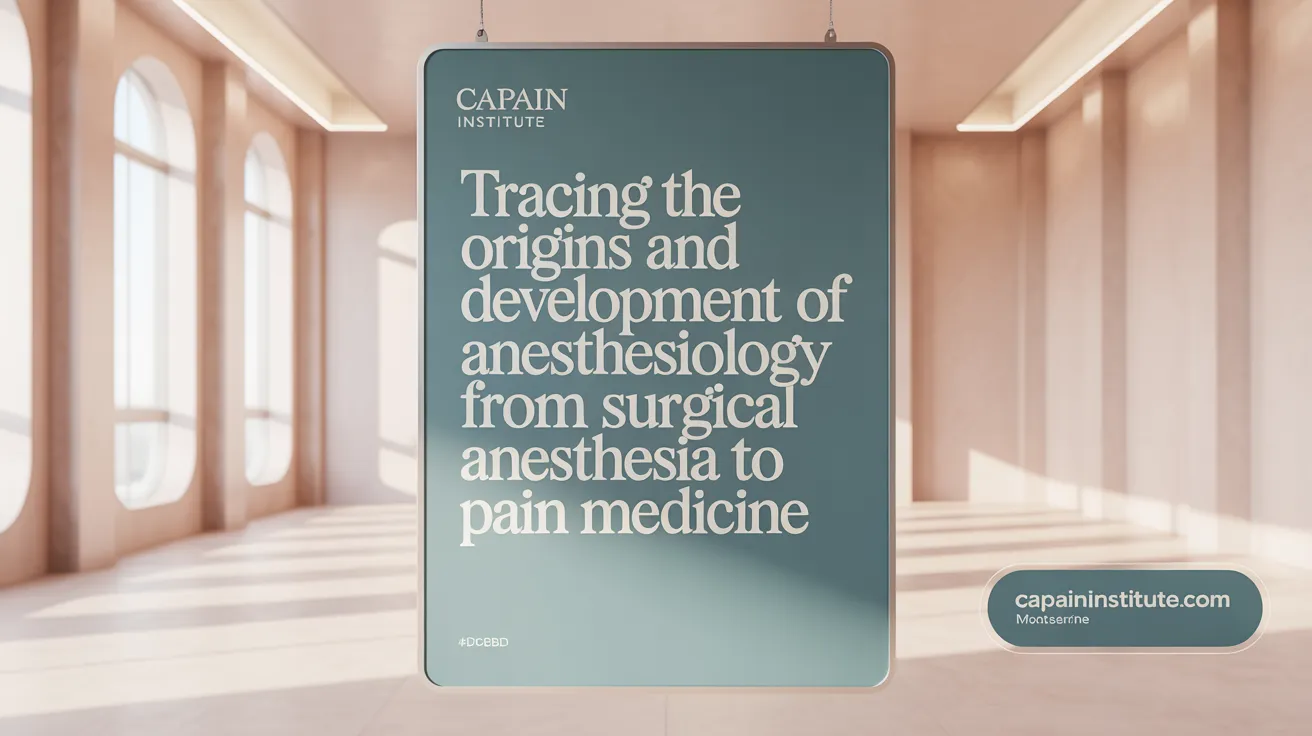Anesthesiology: The Cornerstone of Pain Medicine
Pain medicine has evolved into a vital subspecialty of anesthesiology, a field originally dedicated to alleviating suffering during surgical procedures. This article explores how anesthesiologists have shaped pain management through clinical excellence, innovative techniques, multidisciplinary collaboration, and advocacy. Their pivotal role spans from the perioperative setting to chronic pain care, making anesthesiology indispensable to modern medicine.
<!-- VIDEO:eyJsaW5rIjoiaHR0cHM6Ly93d3cueW91dHViZS5jb20vd2F0Y2g/dj1pSE9QQ3ZOVnlZbyIsImltYWdlVXJsIjoiZGF0YTppbWFnZS9qcGVnO2Jhc2U2NCwvOWovNEFBUVNrWkpSZ0FCQVFBQUFRQUJBQUQvMndDRUFBa0dCd2dIQmdrSUJ3Z0tDZ2tMRFJZUERRd01EUnNVRlJBV0lCMGlJaUFkSHg4a0tEUXNKQ1l4Sng4ZkxUMHRNVFUzT2pvNkl5cy9SRDg0UXpRNU9qY0JDZ29LRFF3TkdnOFBHamNsSHlVM056YzNOemMzTnpjM056YzNOemMzTnpjM056YzNOemMzTnpjM056YzNOemMzTnpjM056YzNOemMzTnpjM056YzNOLy9BQUJFSUFGTUFsQU1CSWdBQ0VRRURFUUgveEFBYkFBQUJCUUVCQUFBQUFBQUFBQUFBQUFBQUFRTUVCUVlDQi8vRUFFSVFBQUlCQXdNQkJBWUhCUVFMQUFBQUFBRUNBd0FFRVFVU0lURVRRVkdSQmhRaVlYRnlJekl6Z2FHeHdSVkNWSlBoVW1MUjhBY1dRMFJGYzRLRHN0THgvOFFBR0FFQkFRRUJBUUFBQUFBQUFBQUFBQUFBQUFFQ0F3VC94QUFmRVFFQkFRQUJBd1VBQUFBQUFBQUFBQUFBQVJFaEFoSVRJakZCWVpILzJnQU1Bd0VBQWhFREVRQS9BUFJJdlJlL054cU53MnYzYkplbEdpaHl3V0FEbkF3M3Z4d0Y0QXpuclZvdWtYbk9kYXUrUUJ3cThZQUhHUWZBbjc2bDNTVFBaUmlBblBzNUFPQ1J4bW85dEhlaVZTL1R2MmpBSEh3L3hvdDZybU9qcHQ4ZitOWFBQWEVNWC9yeFVxd3RaYldObG11NWJsbWJPNlFESThxcHBwOVphOXVJdFB2ZE5sQWtQMGNwTzZQd1hqM0FuenBsWnZTUHRKVWh1OUpsYmwxRGs1QU9jZE83ajhLSTFORlpxYWJYSkxXTVdsNXB1VEd5eVNzMlNKQVdEYmU3QTlrY2o0MDNOZCtrWFpPOGQxb28yZzhzV3dDQU05L2pRYW1pczdmdnJwdlMxbGQ2ZWtLWTJSeUg2K1FNN3UvcWVNSHZGTjNWN3E3cm5UYnZTcE96aVZaZ1hPUkwrOEJ6NGRBYURUVVZubzU5Y09taDJuMHYxcDVmWVBPd3BqNDh0bkZRWXIzWHc2UlEzK2tYRzVlMERPM3RiRDBZNHh3Y0hIOUtEWDBWbnROYlhua25hNHVOUGxUREJSRms3SkFPQjhQSGttdUhiMHNEUkFMcHAzTVF4d3hDanhQSVBQdW9OSlJWZnBYN1EyUCswK3gzN3ZaN0lZR1BNMVlVQlFhS0R6UWVYNnRwdHJkK2xGN0hlU1BHSlpIS0ZFQlBIWi9IKzJhcXRLdE5Mdm5ObytweFNQR1NZeEhHcXRJZzRKT092VWMvZ0s5R3YvUkhTcitTNmVkWncxMW50VEhNVXo5NDVIU3EvU2Y5RzNvenBGN0JlV050Y3BMQXJMSHV1cEdVS2M1R0NjWTU4NjVlT092bHJ5VFY0YmFHNndqc1ZPN0hBNHc3TDQvM2FLOWgxTDBhMHhyamMwYnNTTWtsczBsYy9GWFR6dE5COWhIOG8vS25LYmcrd2orVWZsVGxlbDVsYWREMDQ2aU5STnVEZEsyNFNiandjRWRNNDZFMHhINk9hUmF5bWVLMEN2c1pDUXpIMldHQ092aFZ6VWJVSmJhSzN6ZVNSeHhNUXVaTVl6M2RhQ3NuMERTWnJLRzBhMGNSUUJ4RmpkbE4zVWpQNjB3UFJYUXV6Q215a2JvUzI1K2NZOEQ3cWtNMmtSTW83ZUFGVk1pbFZCQVZjWk9RTzdpdVEraXhSc1Z1YlhzNDl1VEdGWUxuT09nOEFhSnlXNjlIOUh1N2w1N216WjVaR1ZpU1g1SUFBNy83bzhxNFBvMW9tUXpXVDVYb3haOGo3ODA4eTZVQW9lNHRjU01jRWxEdUk2K1dmeHBGYlIxSkl1N01jWnlHVHA0NW9jdVQ2UDZPMXRGYkd5WXhRc3pJQ1hPMHNRVHpueEFwdi9WalFpbXc2ZXhYR0R5LytQdnFhczlqWjVoUzlnaTU1VGNnT2VuVDd2d3FaRjlMR3NrZHh2UmdDckx0SUk4UWFIS3JOMXAzbzlDbHZFcXdwSVdjSTduSjZaeG5KN3hRL3BIYXg3ZDVqWGR1MjVjODdUZzkzY2VQT25kVmlRcVRQRkhLRlVuZE13VlFjamcvSDlLaFBQYW1NR1NPQXhNT1MxMHBBNXo0OCtOWEUwOUg2VVdVcnFrY2tURm1DakVoeGs0d000L3ZEekZXUHJVLzhNUDVuOUtwVmt0V3dCYTI2a242TUdkY3MyNEFZQTkvNVU1KzBVOXZqMlVHZHh2RndRZWg2OU9SNTFjTlczclUvd0RERCtaL1NqMXFmK0dIOHorbFZSdndWQlRzMnp3RzllWEdjREk2KytrR294bGR3S2NFY0M5VS9pRDQwdzFiZXRUL0FNTVA1bjlLQmRUWjV0Z1ArNS9TcXlLODdXUjBqak1oVlMzc1hRSkl4a2NaNytQT3BNSGF1MzBzTWtReG5KbTNaOHFZYWMxQS9UTDh2Nm1palVQdGwrWDlUUldXc1NrbWlpaWpFa2lLU293R1lEUEZPSk5HNmRvcm9VL3RCdUtwOVZUVG05VU9vdTZrSjdBR2NIbFNmeXg4R1BqVWNXdWlHUkdXWWx0eUVJQURsc2pCeHQ3ejE4ZXZ2ck91czZKWnZQNHYwbmllUjQwa1JuVDZ5aGdTdnhIZFRNald0M0ZKSElZWm93ZHJxU0dBSVBRKzhHb1Z2cDlwZGxic05LMkpTNmhpTUE3aWVPT21lLzhBSEZMSm9kbEpJcnNIM0E3ajBPVGtuSnlQZWZkK0ZYYXpuUjgxSWlzYkNOQ1k3VzJWTU1jcWlnZTFqZDU0SGxTTHBtbkNJeHBZMm9qYkdWRVM0T09uSHVxS2ZSNndLTWpDUnR3WUVzUVRnZ0R2SHUvT3A5cGJSMnNSaml6Z3V6blBpVGswbXBaMC9GUnJyVHROUzF6SllXenh4WlpWTVM0SGpqamltYmV4MHZVcll0NmpBQnZ3ZGk0d1FjOE1NZC9OVkhweHJZc093c3daUUpWTFRHTWRFNmNudzYxbkxhU2V4TU56cHpNWGxsSitqM00wZ1hHZUFPVjVBOE90WnZWNnNNNGVnUG9tbHlYRHp5V0Z1MGpuTEZrQnllZWNkTThubjNtcDBTSkRHSTRsVkVIUlZHQUthc1oydWJPQ2Q0bmhhU01NWTNHQ3BJNkducTJ5aWFtTXd2a2tmVk9Rd0dPUjNuaXFkWFl5S0RjU0R4SGJ3SDhNZmxWdnFjalJvemJZU2dYMmpLK0FEa1l6d2ZmNUQ3cXNYMExJeFMyc21LY25Fb3gvNGVQaG10TVVuYXlBSDI1UUZiZHpOQWNaN3VuVEpHUGlPYVF5emRrenBLVGxSc0xTd2puZzR6dDQ5L1d1M3Y0QWpzWWJNRlNVOXFVQThEcDlYNFVvdklUTVlSYjJYYUE3RVh0ZjNzajJUN0hIZjk0OHFPTzFkTjZ5c3pZVWdvWjRRVjQ2OEFZUEZPOWxjbUVGUk9lTndJZUxjZTdHY1lJeHp6WEl2NFdhTXZEWWd2Z2s5dUNjZUk5bm5tbGZVekFxcUJhQURLaFJOakJIZDlYdUdQT29ISW83cDVBVDZ4R3JaNUxSZlJqcjRaOTFTa3Q1RllNYnlkd1AzV0NZUGt0UkcxUW9wRGkyTW9JNEUvR01aOFBoM2Q5U0xPNWx1VUVteURzbXpoNHB0K2V2UFFlRlVPNmg5c3Z5ZnFhS05RKzJYNUIrWm9yRFo0Mmx2Y0pBODhLU01pQUtXWE9PVlA1cXArNFVKcDFtbU5sdWk0SUl3UERwV1g5SmJ6VkxmVWJTT3hra1dCbzRONEFmR3dtVHRDdTFUbC9zOEE4VkEvYkdzUXRtN3ZwakZJWXpFa1VTaHlUdFVya2puMmhrQWQ3ak9RZUdSZTYrMnZRRlZZMENMd29HQVBDa3g0MTV5dXJhM05iZHBhWGx4Y04yempNa1JSY1pqem5zOTJPTitCNDU5MWJuUlhsazBpMWU0YVJwU25KbFhheDhNakE1b2laUlJSUVlyL1NYcE45cVVOaTJuUVJTT2pPcm1SaU1LUU83djVGZCtpMm1pMnZiTjU1bWttdDRUR2lLQUVVRUhKOFNhdGZTcSs5VFMzQUtaa0pBRE9GSGRVSFFKV2JXV1ZvOWhBTzVRZWpjNUZjNzJ5OGU3WHFzK21zcEtLSzZNb3VvcTd4T3NZSmZBeGh0cDYrTlZ6d1hwQTI5dnVHZWZXaDRmTDdxbmFxaW1KbmJxcTRHUzJPbzdsNjlQODgxVXBMbU5nckt3Q25sWG15RGtZK1BOYVlxVzhGMjBuRHpCVDF4UDBJNmNiZmdhRXQ3cVdUNlpwWTBKM2V4Y2JzRVlJR052K2ZmVUV5ZG0rMXBvaGtnSDJwdmFJLytmaFhUbERBcVBLTnhVWUFhWXF5OURuNy9BQ3FpMDlVNFlHNnVUdUJHZTB3ZVFmQWUra2F6Si8zdTZIR0RpVHIrRlYwYlFzdTB5S1N2SjJ5Uyt6MC9UUEZJdnMzSVBhaFdKRzFWa213U1NEMDZEZ21nc3pablp0OWF1Z1BIZU05TWVGT1J4R05uWXl5dnU3bk9Rdnc4NnBJeU8zQWltUTRZWUJrbnlmRFBkNFZhV2R0SkJJNWZidEtnS0JJNXg3c0hqeG9IdFErMlg1Qitab28xRDdaZmtINW1pc054anZUajFZNnRwN1NhZkJjWE1Gc0xtT2JZaXpSOW51YkN5TmtESnhnRURoWGJKMm5GQllCTEMzbm1lK1MzUzRtM3UwV096QktvR2t3cjVZajJTM1RhQVNDTVpPaTlNcG5qMVd5VllvblVpMUxNN3dJWWdHbHpLREtwM0ZPT0Z3ZmFQalZVa1hyRnJQRmEyRUx5a085MUhOdWkzcU52c3FSejdMTXJqYVAzaU03aXhJUmJpMXVaTFBUYnllVzRaRE9pM0Z4cU1rU3JNQWQ2QVRETWlnTjNqam5IR2E5TDBlV1NYUkxHVm8wamRvVkxSeFNMSXE4ZEF5OEVEb0NLOGhzTEtPWVhOM2NXdHRiWFVEYjRwbzdab1pJbzJRckdPeXhrbDI1SUJ5Qkp6ampIc1BvOUExdG9samJ5UlJSTkZBaUZJbzJqUmNER0FyY2dmRTBEK1pmQStWR1pmZjVWS3hSaXBpc3I2VzJzdW8yb3N6REt3a0gxMVFuYjdRNS9DcEVzY2tXdFJ5UjI4aDNMOWRWNEhHT1Q4QUswVkZaN09WMVVtZTQzc3BobTRQR0IxRkJhOFlleW0zNWlUK0EveHEyb3E5cWFyNzl2WktNa3I1WE9JOGduR09NK1BQNTFCeEErNXRsOE91Um1RZUo2ZUhINVZPMUplMFJvOHFDMlByS1NPQ0QzVldMWm50Q3pHMllOOWNHS1RrSE9SOWIzMTBqblV1TzVTTk5peDNUQkNWeVVadW52TkwrMEl6dElqdUR1QUl4Q3g0OHZkVU9XekxqQWFBWVhDNWpsT09QbTU1cnBiUUlTcTlnSWpqSzluSUNjZjlWVVMvWFFmOWhjZVAyWnBmWEJsZ1liZ2JWQnoyUjU2ZFBQcDdqVmZMWUYxQURRZlZBenNrNEl6eVBhOE1VL0JhUUNQYmNLalliSzdBNDdzZDVOQStMOWR4SHE5M2ovQUpMVjFEZUxOSjJZaW1WdS9kR1FCeDQwMExXeURaQ04weGpMNDZFZFB2TlNVa2pWQWlrNEF3TWcwQ2FoOXN2eUQ4elJScUgyeS9KK3BvckRhZGI4d1IvS1B5cGNuQm9vb0ZQVDc2VVVVVUMwVVVVQlJSUlFGRkZGQnl3QjZnZVZJRlgreVBLa29xeEs2MnI0RHlvMnI0RHlvb29nMnI0RHlvMnI0RHlvb29EYXZnUEtqYXZnUEtpaWlxL1VmdGwrWDlUUlJSVVYvOWs9IiwidGl0bGUiOiJUaGUgUm9sZSBvZiBSZWdpb25hbCBBbmFsZ2VzaWEgQmV5b25kIEFjdXRlIFBhaW4gLi4uIiwic25pcHBldCI6IlByb2Zlc3NvciBDYXJsaSBpcyBhIGdpYW50IGluIHJlZ2lvbmFsIGFuZXN0aGVzaWEsIGFjdXRlIHBhaW4gbWVkaWNpbmUsIGFuZCBlbmhhbmNlZCByZWNvdmVyeSBhZnRlciBzdXJnZXJ5LiBJbiB0aGlzIHRhbGssIEkgc3VtbWFyaXplIG15IC4uLiJ9 -->Foundations and Evolution: The Birth of Anesthesiology within Pain Medicine

How has anesthesiology historically developed within the field of pain medicine?
The origin of anesthesiology as a discipline closely ties to the pursuit of effective pain relief during surgery in the 19th century. Pioneers like William Morton and John Snow introduced the use of ether, chloroform, and nitrous oxide, revolutionizing painless surgery. These advancements laid the groundwork for anesthesiology not only to excel in operative anesthesia but also to address broader pain management needs.
As the field matured, anesthesiology expanded beyond initial surgical applications. The creation of the International Association for the Study of Pain (IASP) was a significant milestone, with American anesthesiologist John Bonica contributing to its foundation. This organization emphasized the importance of understanding pain as a distinct medical challenge and fostered research into specialized pain therapies.
Over time, anesthesiology formalized as a medical specialty with dedicated training programs. In the United States, the first pain residency was approved in 1992, reflecting the recognition of pain medicine as a subspecialty. Since then, anesthesiology has grown to address a continuum of pain, from acute surgical discomfort to chronic and malignant pain conditions.
Today, anesthesiology encompasses various techniques such as regional nerve blocks, multimodal analgesia, and innovative interventions like ultrasound-guided blocks. The specialty continues to evolve, integrating research, technology, and multidisciplinary approaches to improve pain management outcomes for diverse patient populations.
This historical development highlights anesthesiology’s transition from basic operative anesthesia to a comprehensive field dedicated to understanding and treating pain at all levels, reinforcing its central role in modern pain medicine.
Perioperative Excellence: Anesthesiology’s Central Role in Surgical Safety and Pain Control

How do anesthesiologists contribute to pain management throughout the perioperative period?
Anesthesiologists play a crucial role in managing pain before, during, and after surgery to ensure patient safety and comfort. Before surgery, they conduct detailed evaluations, reviewing patient history, physical exams, and labs to prepare an individualized anesthesia plan. During procedures, they employ advanced techniques such as regional nerve blocks, multimodal analgesia, and sedation to control pain effectively and reduce reliance on opioids. These measures help facilitate smooth surgical experiences and faster recoveries.
Postoperative pain management is equally important. Anesthesiologists provide therapies like epidural analgesia and patient-controlled analgesia (PCA), optimizing pain relief while minimizing side effects. Their involvement in protocols like Enhanced Recovery After Surgery (ERAS) has standardized perioperative care, leading to fewer complications, quicker recoveries, and decreased dependence on opioid medications. Overall, their comprehensive approach ensures holistic pain control aligned with patient safety.
Why is anesthesiology important for surgical safety and perioperative care?
The importance of anesthesiology lies in its central role in maintaining patient stability during surgery. Anesthesiologists continuously monitor vital signs such as heart rate, blood pressure, oxygen levels, and respiratory function to promptly detect and correct issues. Their expertise in airway management and circulatory support directly impacts patient safety, preventing serious complications like respiratory distress, hypotension, or cardiac events.
Beyond intraoperative monitoring, anesthesiologists ensure effective communication within the operating team, implementing safety protocols and emergency procedures when needed. Their vigilance extends into postoperative care, where they manage pain, prevent infections, and oversee recovery to facilitate optimal outcomes. Their key contributions make surgical procedures safer and more predictable, ultimately saving patient lives and improving quality of care.
Mastering Pain Control: Practices, Techniques, and Strategies in Anesthesiology
What practices, techniques, and strategies are commonly used in anesthesiology for pain control?
In anesthesiology, managing pain effectively involves a range of practices and advanced techniques designed to reduce patient discomfort while ensuring safety. Regional anesthesia techniques are a cornerstone, including epidural and spinal blocks used in surgeries such as cesarean deliveries and orthopedic procedures. Fascial plane blocks like the erector spinae plane block and serratus anterior block are increasingly popular for postoperative pain relief in chest and abdominal surgeries.
Multimodal analgesia, another vital strategy, combines various medications to maximize pain relief and minimize side effects. This approach includes NSAIDs, acetaminophen, ketamine, gabapentinoids, and local anesthetics. By targeting different pain pathways, multimodal analgesia achieves better control, reduces the need for opioids, and shortens recovery times.
Preemptive nerve blocks are performed before surgical incision, and ultrasound guidance enhances the precision of nerve and fascial plane blocks, resulting in improved outcomes. These techniques are carefully chosen based on the type of procedure and individual patient factors to optimize recovery and reduce complications.
| Technique | Example | Benefits | Additional Details |
|---|---|---|---|
| Epidural and Spinal Blocks | Cesarean, lower limb surgery | Effective for pain relief, reduces opioid use | Technically demanding but highly effective |
| Fascial Plane Blocks | Erector spinae, serratus anterior | Postoperative pain control, faster recovery | Ultrasound-guided, increasing safety and accuracy |
| Multimodal Analgesia | NSAIDs, acetaminophen, gabapentinoids, local anesthetics | Enhanced pain control, fewer opioids, fewer side effects | Tailored to patient and procedure-specific needs |
These practices exemplify how anesthesiology continuously advances to provide safer, more effective pain management tailored to each patient, emphasizing the importance of personalized care.
Beyond the Operating Room: Managing Acute and Chronic Pain Conditions

What is the role of anesthesiology in managing acute and chronic pain conditions?
Anesthesiology plays a vital role in both immediate and long-term pain management. For acute pain, especially post-surgical pain, anesthesiologists utilize regional nerve blocks such as epidurals and peripheral nerve blocks, along with multimodal analgesia strategies, to control pain effectively and reduce reliance on opioids. These techniques not only provide effective pain relief but also facilitate faster recovery and diminish the risk of opioid dependence.
In chronic and cancer-related pain, anesthesiologists adopt a broader, multidisciplinary approach. They employ advanced interventional procedures, including implantable devices like nerve stimulators, and leverage non-pharmacologic treatments such as physical therapy and psychological support. This comprehensive approach addresses the complex biopsychosocial factors that influence pain, optimizing quality of life and preventing pain from becoming an ongoing, debilitating condition.
Through personalized treatment plans that combine pharmacological, technological, and holistic strategies, anesthesiologists ensure effective pain relief tailored to each patient’s needs. Their expertise in managing the intricate nature of pain makes them central to lifelong pain management, supporting both physical recovery and emotional well-being.
A Multidisciplinary Specialty: Collaborative Approaches in Pain Medicine

How is anesthesiology multidisciplinary, and what related specialties are involved in pain management?
Anesthesiology is inherently a multidisciplinary field that collaborates with various healthcare specialties to provide comprehensive pain care. It works closely with disciplines such as surgery, critical care, emergency medicine, physiatry, neurology, psychology, and rehabilitation therapy.
Physician anesthesiologists lead these teams by integrating different diagnostic and interventional techniques, including nerve blocks, pharmacological therapies, and physical rehabilitation methods. For example, in managing complex chronic or neuropathic pain, multidisciplinary programs often combine medication management, psychological support, and physical therapies for optimal outcomes.
This teamwork approach addresses the multifaceted nature of pain, which involves biological, emotional, and social components. Programs like multidisciplinary pain management pathways exemplify this collaboration, aiming to reduce reliance on opioids, improve patient satisfaction, and enhance overall treatment effectiveness.
How do team-based care models improve pain management?
Team-based models facilitate personalized care plans tailored to individual patient needs. They foster communication among healthcare providers, ensuring coordinated efforts that target various aspects of pain.
This integrated approach not only maximizes treatment efficacy but also minimizes risks associated with treatments like opioid therapy. Ultimately, multidisciplinary and team-based concepts in anesthesiology elevate the standard of pain management, making care more holistic, efficient, and patient-centered.
Education and Advocacy: Advancing Pain Medicine Through Leadership and Policy

How do educational and advocacy efforts highlight anesthesiology’s impact on pain medicine?
Educational initiatives play a vital role in equipping anesthesiologists and healthcare professionals with skills in advanced pain management strategies. These programs focus on multimodal approaches that minimize opioid use, emphasizing the importance of safe prescribing practices and the latest techniques in regional anesthesia, such as nerve blocks and ultrasound-guided interventions.
Professional organizations like the American Society of Anesthesiologists (ASA) lead these efforts by developing comprehensive educational materials and organizing training sessions. These initiatives aim to improve knowledge, promote best practices, and foster innovation in pain care.
Advocacy efforts extend beyond education to influence public policy and healthcare regulations. The ASA has been proactive in advocating for policies that expand access to nonpharmacologic treatments and support research funding for pain management. For example, they organize Pain Summits that bring together medical professionals and policymakers to discuss strategies for reducing opioid dependency and improving pain treatment.
One notable contribution is the development of Pain Alleviation Toolkits designed to promote safe postoperative pain management and opioid stewardship. These resources guide clinicians in implementing protocols that prioritize patient safety, reduce misuse, and incorporate multidisciplinary pain management approaches.
Through these combined educational and advocacy activities, anesthesiology demonstrates its leadership in shaping effective, ethical, and patient-centered pain medicine practices. This approach not only advances clinical outcomes but also addresses critical issues like the opioid epidemic and equitable access to pain care.
The Expanding Horizons: Anesthesiology’s Broad Scope in Modern Medicine

What are the specialty areas within anesthesiology related to pain and critical care?
Anesthesiology is a diverse field that covers a wide range of subspecialties. It includes pediatric anesthesia, obstetric anesthesia, neuroanesthesiology, cardiovascular anesthesia, and critical care medicine. Many of these areas involve focused expertise in managing complex pain conditions, during or after surgeries, or in critical care settings.
Pain medicine itself has evolved into a distinct subspecialty, often involving advanced treatments for acute, chronic, and cancer-related pain. Techniques like regional anesthesia and nerve blocks, including ultrasound-guided nerve stimulation, are scientifically validated and play a vital role in pain relief and recovery.
Critical care anesthesiologists are specialists who manage critically ill patients, providing respiratory support, cardiovascular management, and emergency trauma care. They develop response plans for emergencies and are involved in organ donation procedures, including maintaining physiological stability for transplantation.
What roles do anesthesiologists have beyond surgery?
Beyond the operating room, anesthesiologists extend their expertise into outpatient clinics, emergency departments, and specialized areas like trauma teams and organ transplantation units. They oversee anesthesia for procedures such as radiological imaging, gastrointestinal endoscopy, and cardiac testing.
In the realm of pain management, anesthesiologists treat chronic pain conditions like migraines, back pain, and other persistent pains, adopting a biopsychosocial approach to improve patients’ quality of life. They lead efforts in perioperative medicine, encompassing preoperative assessment, optimizing patient health, and postoperative recovery.
Anesthesiologists also play a crucial role in disaster response, developing protocols and training medical teams to handle emergencies efficiently. Their involvement in patient safety, research, education, and hospital administration underpins high standards of care and innovation across healthcare settings.
How have technological innovations and research advanced anesthesiology?
Recent technological developments have significantly enhanced pain management. Techniques such as nerve stimulation, ultrasound-guided nerve blocks, and new drug delivery methods, including multimodal analgesia, allow for precise, effective, and safer pain control.
Research in anesthesiology also focuses on understanding mechanisms of consciousness, reducing cognitive dysfunction post-surgery, and finding less impactful medications for pain. Advances like Enhanced Recovery After Surgery (ERAS) protocols promote evidence-based perioperative care, leading to faster recovery, fewer complications, and better patient outcomes.
Institutions like UCLA are investigating the biological mechanisms behind anesthesia and pain, contributing to innovations that reduce reliance on opioids and improve safety. These innovations exemplify how anesthesiology continues to evolve, broadening its scope well beyond traditional roles.
| Subspecialty Area | Focus | Innovative Techniques | Contribution to Patient Care |
|---|---|---|---|
| Pediatric Anesthesia | Child-specific care | Tailored pain management, regional blocks | Improved outcomes in young patients |
| Obstetric Anesthesia | Labor and delivery | Epidurals, non-opioid analgesics | Maternal and fetal safety |
| Neuroanesthesiology | Brain/spinal surgery | Neuro-monitoring, protective strategies | Enhanced neurological outcomes |
| Critical Care | ICU management | Advanced ventilators, organ support | Saves critically ill patients |
| Pain Medicine | Chronic and acute pain | Nerve stimulation, multimodal analgesia | Reduced opioid dependency and improved recovery |
Anesthesiology stands as a dynamic, multidisciplinary field making substantial contributions to patient care, driven by technological progress and dedicated research.
Anesthesiology: An Indispensable Pillar in Pain Medicine
Anesthesiology remains fundamental to pain medicine, combining scientific innovation, clinical expertise, and compassionate care to relieve suffering across the spectrum of acute and chronic pain. From ensuring surgical safety to pioneering advanced regional anesthesia techniques and advocating for responsible opioid use, anesthesiologists shape pain management's past, present, and future. Their multidisciplinary collaboration and leadership in education and policy continue to elevate standards of care. As pain medicine evolves, anesthesiology’s comprehensive approach will remain vital to enhancing patient outcomes and transforming lives.
References
- Anesthesiology and pain medicine - PMC
- Pain Medicine
- Role of the Anesthesiologist
- What is Anesthesiology?
- What Does an Anesthesiologist Do? | Made for This Moment
- What it's like in anesthesiology and pain medicine
- Beyond the operating room: Unveiling the pivotal role ...
- Anesthesiology | UC Davis Health
- The Role of the Anesthesiologist
